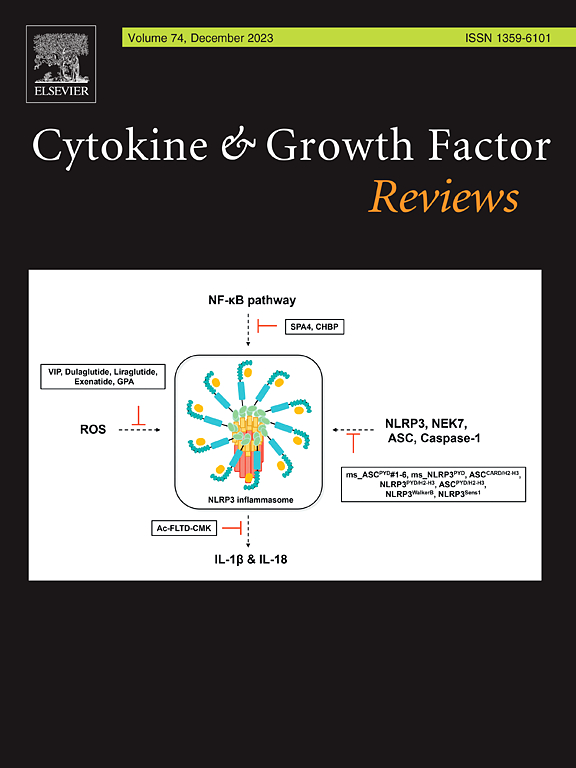Wiring and rewiring PANoptosis: Molecular vulnerabilities for targeting inflammatory cell death in human disease
IF 11.8
2区 医学
Q1 BIOCHEMISTRY & MOLECULAR BIOLOGY
引用次数: 0
Abstract
PANoptosis represents a unified inflammatory cell death program that mechanistically integrates pyroptosis, apoptosis, and necroptosis through multiprotein complexes known as PANoptosomes. While prior models treated these death pathways as distinct, emerging evidence reveals their convergence through shared sensors, signaling adaptors, and executioners—allowing cells to bypass immune evasion strategies by pathogens or tumors. Despite its biological importance, a cohesive mechanistic framework for PANoptosis has remained elusive. In this review, we present a novel, sensor-specific dissection of PANoptosome architecture, detailing how distinct innate immune sensors—ZBP1, RIPK1, AIM2, and NLRP12 serve as organizing hubs for context-dependent activation of inflammatory cell death. We integrate this with a cross-pathway analysis of caspase-8, RIP kinases, and gasdermins, revealing PANoptosis as a highly adaptable logic circuit governing immune activation and cell fate. We further chart the dual roles of PANoptosis across disease contexts—highlighting its protective functions in infection and tumor suppression, as well as its detrimental consequences in cytokine storms, neurodegeneration, and multi-organ failure. By comparing sensor-driven outcomes across organs and disease states, we propose new therapeutic entry points for modulating PANoptotic signaling with precision. This review offers a mechanistically integrated and translationally focused roadmap to PANoptosis, establishing it as a master regulator of inflammatory cell death and a frontier for next-generation immune interventions.
PANoptosis:人类疾病中针对炎症细胞死亡的分子脆弱性。
PANoptosis是一种统一的炎症细胞死亡程序,通过称为panoptosome的多蛋白复合物,将焦亡、凋亡和坏死凋亡机制地整合在一起。虽然先前的模型将这些死亡途径视为不同的,但新出现的证据表明,它们通过共享的传感器、信号适配器和执行器而趋同——允许细胞绕过病原体或肿瘤的免疫逃避策略。尽管PANoptosis具有重要的生物学意义,但其内在的机制框架仍然难以捉摸。在这篇综述中,我们提出了一种新颖的,传感器特异性的PANoptosome结构解剖,详细介绍了不同的先天免疫传感器- zbp1, RIPK1, AIM2和NLRP12如何作为炎症细胞死亡的上下文依赖性激活的组织中心。我们将其与caspase-8、RIP激酶和gasdermins的交叉通路分析结合起来,揭示PANoptosis是一种高度适应性的逻辑电路,控制免疫激活和细胞命运。我们进一步描绘了PANoptosis在疾病背景下的双重作用——突出其在感染和肿瘤抑制中的保护功能,以及在细胞因子风暴、神经退行性变和多器官衰竭中的有害后果。通过比较不同器官和疾病状态的传感器驱动结果,我们提出了精确调节泛光信号的新治疗切入点。本综述为PANoptosis提供了一个机制整合和翻译聚焦的路线图,将其确定为炎症细胞死亡的主要调节因子和下一代免疫干预的前沿。
本文章由计算机程序翻译,如有差异,请以英文原文为准。
求助全文
约1分钟内获得全文
求助全文
来源期刊

Cytokine & Growth Factor Reviews
生物-生化与分子生物学
CiteScore
21.10
自引率
1.50%
发文量
61
审稿时长
22 days
期刊介绍:
Cytokine & Growth Factor Reviews is a leading publication that focuses on the dynamic fields of growth factor and cytokine research. Our journal offers a platform for authors to disseminate thought-provoking articles such as critical reviews, state-of-the-art reviews, letters to the editor, and meeting reviews.
We aim to cover important breakthroughs in these rapidly evolving areas, providing valuable insights into the multidisciplinary significance of cytokines and growth factors. Our journal spans various domains including signal transduction, cell growth and differentiation, embryonic development, immunology, tumorigenesis, and clinical medicine.
By publishing cutting-edge research and analysis, we aim to influence the way researchers and experts perceive and understand growth factors and cytokines. We encourage novel expressions of ideas and innovative approaches to organizing content, fostering a stimulating environment for knowledge exchange and scientific advancement.
 求助内容:
求助内容: 应助结果提醒方式:
应助结果提醒方式:


